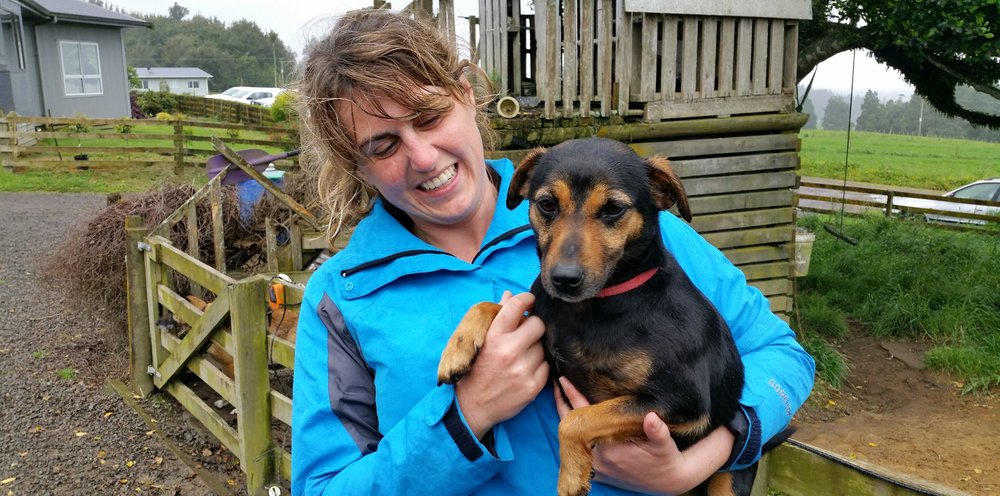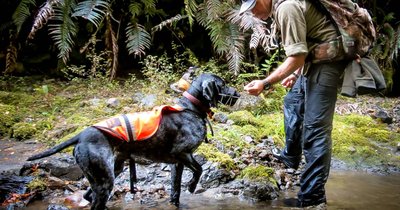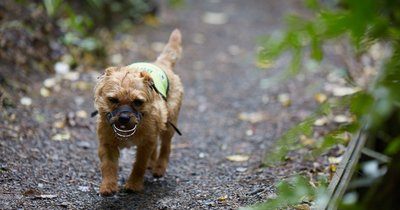Choosing a dog to take home from the pound is one thing but getting the right dog for the important work of conservation is another, like Hannah (pictured) who found the perfect pest detection dog in Indie. We spoke to Guus Knoppers, a renowned dog trainer, owner of K9 Detection and one of the Department of Conservation’s contract handlers, to find out just what it takes to be a good, no wait, “great” conservation dog.
It’s a dog’s life
Guus Knoppers has trained dogs from all walks of life for over 20 years. From beloved family pets to the abandoned strays rescued from death row, he trains dogs for a wide range of roles from bomb detection to companion dogs, pest detection, and agility. Guus is also an approved aversion trainer, helping to stop pet dogs attacking native birds, assisting other conservation dog trainers with advice and helping them to get their dogs through the required certification.
Originally from Europe, Guus started up his business K9 Detection about five years ago. It’s in his blood. Both his father and his grandfather worked with sports dogs, so Guus has been working with dogs since he was seven years old. When he emigrated to New Zealand he found himself in the lucky position of working with conservation dogs
Guus says that there isn’t a huge difference in training dogs for their particular work – whether it’s explosive work, narcotics, or biosecurity, it’s all about targeting odours. While he prefers not to use dogs with a food drive, all he really wants is to work with dogs who want to work with him. Yes, that’s a thing. Dogs, like us humans, have a natural drive to work.
For Guus, a good detection dog is one who wants to work and please his handler. So, how can you tell if a dog has that necessary work ethic? Experience. “What I do is I test the dog to see what he wants to work for. I’ll stow something away, like a rodent scent bag for example, and see how long it takes for him to find it. This is how a dog shows me that he’s willing to work.”
You need a good breed
Guus works with all kinds of dogs from work dogs to pound dogs, but he says that terriers, German shorthairs, and springer spaniels are some of the best breeds for conservation work.
He adds, “Any dog can be trained to do this work, but certain dogs will be better than others. And that’s the difference in the dogs that we choose: the more the dog is a lunatic (yes, he said lunatic) the better they are for the work that they do.”
As for the lunacy, the crazier the dog is for a scent, the better he is at doing his job. Some handlers like to use pointers, it all depends on the task that the dog has to do. All hunting breeds are the best ones for the conservation work.”
When it comes to good traits for pest detection work, Guus says terriers stand out by far. Selecting the dogs for conservation work is glorious work, but it certainly isn’t pretty. “We select the dogs by taking targets out."
"For a rodent dog we find all the dead rats we have on hand and tie them onto a piece of rope to see if the dog wants to chase it. If they do, we’ll start hiding the dead rats in the long grass, and if and when the dog comes by, if he’s up to the job of sniffing them out, we know the dog is 60-70% there.”
And if they’re not into the rats? “We look for another nut case that has the drive we’re looking for."
"It’s such important work that you want the dog to want to find the rat, you don’t want to have to teach them.”
Working like a dog
Guus believes in training dogs in an environment where they’re rewarded for the work that they do. He says that dogs should have a purpose in their lives. “Dogs are animals and natural hunters. Hunting comes naturally to them. It’s what they’re born to do.” And he should know, Guus lives with 15-20 dogs at any given time.
Guus says that some handlers use tactile rewards like petting and patting and giving dogs attention to reward them for their good work. “I personally think that a toy reward after they find their target is a better reward.” As a firm believer in finding the right reward for a particular dog, Guus knows that some rewards work better on some dogs than others. “Would you rather work for $5 or $100? You get better work out of someone or some dog if you tailor the reward to their specific needs.” Guus’ dogs work anywhere between 6-10 years. That’s a pretty sweet career.
Great handlers love their dogs
Guus does not beat around the bush when asked what he loves about the work that he does. “I’d rather work with dogs than with people.” For him, the work he gets out of a dog and the enjoyment, and pride he feels when his dog finds something like the stoat that’s killing the takahē, is like nothing else. “It’s something that makes me so proud, even if he does it once in a lifetime, it’s worth all the hard work I’ve put into training that dog.” He goes on to tell a story about the work he did at Pukaha Mount Bruce where a ferret had killed several kiwi, and they had put traps out but came up with nothing. Then, they brought a conservation dog in and the dog indicated to him that there was something living in an occupied house on a nearby property.
Sure enough, the next day they caught the ferret that killed the kiwi.
The pressure to be great doesn’t just lie with the dogs. It’s a team effort: both the dog and his/her handler have to want to excel. To be a great handler Guus says you need passion, patience, and a willingness to observe your dog and learn from the mistakes that both of you make. He adds,
“A lot of countries look to New Zealand to see how we work with our conservation dogs. America is good too, but even they follow the New Zealand system for training."
Guus says that Japan just bought another two New Zealand-trained dogs to control their pests.
Guus adds that while he loves his work, and he essentially lives for it, the hardest part of the job is being away from home, especially when his family was young. Which just goes to show that the trainers and handlers working on the conservation front line give up a lot to protect New Zealand and its native species from pests.
The Conservation Dogs and their talented handlers are active all over New Zealand. You might be lucky enough to meet them at wharves, ferry terminals, island and mainland sanctuaries, in the national parks or perhaps even at your local Kiwibank branch so keep an eye out when you're exploring our backyard! A huge thanks to Andrew for sharing his great photos.
Want to find out more? Stay up to date with the programme by visiting the Dog Programme section on DOC's website or check out Kiwibank’s social media channels.



